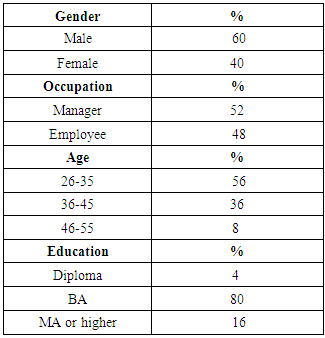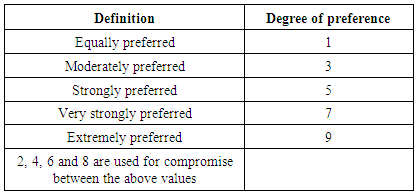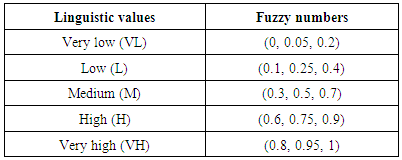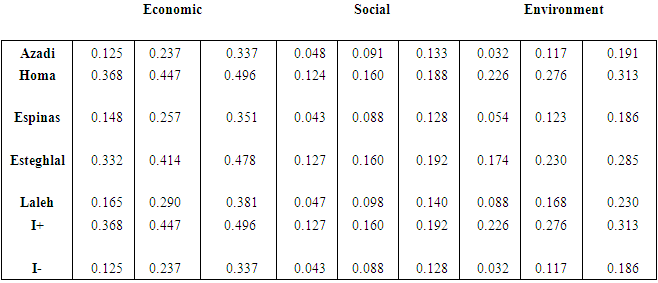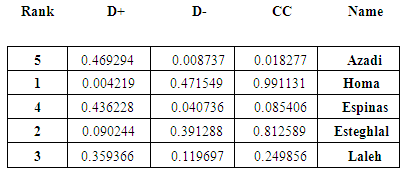-
Paper Information
- Paper Submission
-
Journal Information
- About This Journal
- Editorial Board
- Current Issue
- Archive
- Author Guidelines
- Contact Us
International Journal of Information Science
p-ISSN: 2163-1921 e-ISSN: 2163-193X
2015; 5(2): 30-41
doi:10.5923/j.ijis.20150502.02

Ranking Five Star Hotels in Tehran Using CSR
Jamal Kheiri 1, Enayat Yazdanpanah 2, Morteza Soleymaninejad 1, Fatemeh Sajjadi 3, Masoud Taslimi 4
1MA Student in Tourism Management, University of Tehran, Tehran, Iran
2MA Graduated in Tourism Management, University of Tehran, Tehran, Iran
3MA Graduated in Tourism Management, Maziar Institute of Higher Education, Iran
4PhD Student in Marketing Management, Islamic Azad University of Aliabad-e Katul, Iran
Correspondence to: Jamal Kheiri , MA Student in Tourism Management, University of Tehran, Tehran, Iran.
| Email: |  |
Copyright © 2015 Scientific & Academic Publishing. All Rights Reserved.
This work is licensed under the Creative Commons Attribution International License (CC BY).
http://creativecommons.org/licenses/by/4.0/

Tourism having 11 percent share of our planet’s gross product and as the one of largest industry in the world, has become a major force in our international economies, social lifestyles and understanding of environmental protection. Due to the rising importance of our global interdependence, some concepts like corporate social responsibility (CSR) have a significant role in this dynamic and flourishing industry composed of lodging, transportation and so on. This paper aims at analyzing the concept of CSR as a means of selecting the best practices in the five star hotel brands in Tehran. The three major dimensions of CSR like economic, social and environmental are tried to explain. The paper also presents the results of a study carried out on assessing and ranking the “responsibility level” of these lodging centers. The importance of the criteria used in the CSR-based practices is identified by the analytical hierarchy process (AHP). Moreover, the technique for order performance by similarity to ideal solution (TOPSIS) in the fuzzy environment is used to obtain final ranking of the hotel brands. Results show that among five 5 star hotels in Tehran, Home Hotel takes the best CSR practices. On the contrary, Azadi Hotel is the lowest one in ranking.
Keywords: Corporate social responsibility, Five star Hotels, Tehran, AHP, Fuzzy TOPSIS
Cite this paper: Jamal Kheiri , Enayat Yazdanpanah , Morteza Soleymaninejad , Fatemeh Sajjadi , Masoud Taslimi , Ranking Five Star Hotels in Tehran Using CSR, International Journal of Information Science, Vol. 5 No. 2, 2015, pp. 30-41. doi: 10.5923/j.ijis.20150502.02.
Article Outline
1. Introduction
- Since the 1950s, due to the increasing awareness of people about their rights, the economical, ecological and social activities and practices of corporates had been addressed by private and institutional stakeholders considerably. The people put pressure on the businesses to move on a responsible way and pay more attention to the impact and consequences of their activities. This phenomenon can be explained because of an increased pressure on certain social and economic factors, the greater need for transparency in organizations, and as a reaction to social and environmental disasters (Swaen & Chumpitaz, 2008, cited in (Martínez, Pérez et al. 2012).In an effort to prevent the negative views, many businesses began using their resources to address social, economic and ecological issues voluntarily and make their own brand more popular. Consequently, the corporates’ practices and programs marked the beginning of Corporate Social Responsibility (CSR) if they desire to sustain in the Corporate social responsibly is the continuing commitment by corporates to behave according to business ethics and contribute to economic development while improving the long run (Du, Bhattacharya et al. 2007)Corporate social responsibly is the continuing commitment by corporates to behave according to business ethics and contribute to economic development while improving the quality of the life of the workforce as well as the local community and future generations. They need to think for the society, environment, and all stakeholders of it. More specifically, CSR involves a business identifying its stakeholder groups and meeting their needs and values within the strategic and day-to-day decision-making process (Nižić, Golja et al. 2011).Despite all definitions of CSR, some authors make clear that the meaning of corporate social responsibility may differ among different stakeholders. On the other hand, the measurement of CSR activities is an additional challenge. Unlike the publication of several methods to measure socially responsible activities, almost all of them have some limitations (Aupperle, Carroll et al. 1985). Therefore, the methodology must be adjusted to provide a more complete understanding of the current state of CSR.Since the tourism industry has been labelled “the world’s largest industry” (Miller 2000), yet the lack of CSR in the global tourism industry is “astounding” (Miller 2000), especially given the negative impacts that tourism can have on stakeholders (Kasim 2006).In this industry, regarding to the heavy interdependent relationships that exist between tourism and environment and social heritage while contributing to the health and growth of local communities, it is inevitable that all integrated businesses play their responsible role in the long term. As the contemporary tourist becomes aware of the adverse environmental impact, he/she begins to require the tourist product which is used and paid for to be ecologically and socially acceptable (Nižić, Golja et al. 2011).The development of responsible tourism and the increasing awareness of CSR in the tourism industry causes a strong need to assess and compare the economic, social and ecological performances of tourism companies (Kasim 2006).Corporate social responsibility as the micro aspect of sustainable development means integrating environmental, societal and economic concerns into the core business strategy and further into the main business operations. Tourism businesses should behave responsibly in order to contribute to sustainable tourism development (Jayawardena, 2003). Sustainable development means designing the right mix of economic, social and environmental policies for today and for tomorrow (Strange and Bayley 2008).Therefore, corporates must seek positions that are new, unique, and differentiated from the competitors. In this sense, CSR has become a highly effective attribute for a strategy of differentiation and positioning (Du, Bhattacharya et al. 2007). Many international initiatives show the growing importance of CSR in the tourism and hotel industry. For instance, Agenda 21 set international guidelines relative to sustainable tourism and was created by the World Travel and Tourism Council (WTTC), the World Tourism Organization (WTO), and the Earth Council (Martínez, Pérez et al. 2012).Corporate Social Responsibility (CSR) and its extent has always been a practice usually dictated by the major stakeholders, especially in the industries interconnected closely with the society. As mentioned before, CSR is usually a pledge taken by an establishment or corporation to set in place socio-ethically responsible policies in areas of work ethics, human welfare, environment and human rights (Du, Bhattacharya et al. 2007)Tourism is assumed as an economic phenomenon, but it is actually a human and social activity. The complexity found in tourism is a reflection of complexity and contradictions of today's society, on the one hand, as a consumer good and as spectacle or culture. Economic dimension should have a special importance, but also the other dimensions must be borne in mind in order to gain objective view of the problems that tourism can cause (Nižić, Golja et al. 2011).In the lodging industry, it is expected that most hotels have now incorporated environmental management into their daily operations and implement numerous CSR activities including energy and water conservation, recycling, reusing, and community involvement.More and more hotels now follow international “green” standards, such as the Green Globe Company Standard and Leadership in Energy and Environmental Design (LEED), when building and operating their properties. For instance, all Novotel hotels, managed by the multinational chain Accor, plan to obtain Green Globe accreditation (Idowu and Filho 2009). Through engaging in CSR programs, hotels can also strengthen their relationships with government. All of this shows that CSR can bring about various benefits to different parties. A CSR strategy is not only needed but highly recommendable (Idowu and Filho 2009). Although CSR is now a global trend in the hotel industry, it is pointed out that a recently as a decade ago, hoteliers were not familiar with the concept (Idowu and Filho 2009). As a matter of fact, the number of relevant studies in this area is quite limited, with most of them carried out in a western context in the US and Europe (Kasim 2006).Hotels are as the basic, functional businesses within the tourism industry. All major five star establishments today are owned and run by giant corporations and most of them have adapted a responsible approach of doing business by recognizing that in order to be successful in this current era they will have to focus on the diverse dimensions of CSR. Five star hotels are all spread worldwide and differ based on their comparative and competitive advantage (Idowu and Filho 2009).Because the way corporates define, design, and implement their CSR policies depends heavily on the contextual features of the context in which they operate, this paper suggests a new scale for measuring CSR in the tourism sector, and 5 star hotels in particular, based on the theoretical framework proposed by some researchers (Panapanaan, Linnanen et al. 2003). It should be noted that the researcher conducted the study on the tourism sector, specifically in the hotel segment. With regard to this, it must be stated that the tourism sector has some special particularities because it is possible to identify several subsectors with different characteristics and problems—such as transportation, travel or accommodation(Martínez, Pérez et al. 2013)—that could poentially distort the results of this research if presented together. Since it is expected that 5 star hotels care about the community more and more. This is the main reason why the author decided to focus on a single tourism subsector—the lodging sector—and more precisely in the Tehtan 5 star hotel sector. The aim of this paper is to assess and rank the responsibility level of five star hotels in Tehran, while using AHP and FTOPSIS model.This article is divided into four main sections. The first section presents the conceptual framework that forms the structural basis for the study. The second section generally presents the methodology. The third section composes of the proposed model of this paper and its findings, emphasizing the design of the measurement scale. Finally, a brief conclusion arising from this study are included.
2. Background
2.1. Concept of CSR and Its Three Dimensions
- Overviewing some last decades’ issues, it can be found that the concept of corporate social responsibility was developed in 1953 by Bowen as the obligations of businessmen to pursue those policies, to make those decisions, or to follow those lines of action which are desirable in terms of the objectives and values of the society. In Bowen’s opinion, businessmen are ‘‘responsible for the consequences of their actions in a sphere somewhat wider than that covered by their profit-and-loss statements’’ (Carroll, 1999 ).It was stressed by Davis (1960) who gave a definition of CSR as businessmen’s decisions and actions taken for reasons at least partially beyond the firm’s direct economic or technical interest (Martínez, Pérez et al. 2013). In 1962 Friedman argued that few trends could so thoroughly undermine the very foundations of our free society as the acceptance by corporate officials of a social responsibility other than to make as much money for their stockholder as possible (Friedman, 1970).In spite of some skepticism, many authors including Druker (1984) and Porter and Kramer (2002) have stressed the positive relationships between social responsibility and business opportunities in terms of market opportunities, productivity, human competence and improvement of competitive context (Porter and Kramer, 2002).Various studies in economic and organizational theory have reviewed the role of business in society (Martínez, Pérez et al. 2013). Despite the fact that CSR is a prominent concept in the literature, it is difficult to formulate a precise and comprehensive definition of the term. As Votaw (1972) and more recent authors (Walker, Heere et al. 2010), CSR has a meaning, but its meaning is not the same for everyone. One of the main reasons given is that the meaning of CSR varies depending on the perceptions of the stakeholders involved and on the business sector under study (Carroll 1999, Campbell 2007).The Freeman’s (1984) seminal book the focus moved from legitimacy and morals towards a new theory of the firm (Freeman 1984). Social considerations are thus no longer outside an organization but are part of its purpose of being. CSR thus becomes a question of stakeholder identification, involvement, and communication (Mitchell, Agle et al. 1997).Many definitions of CSR are based on two fundamental ideas. The first is that companies have responsibilities beyond their profit-making activities and mere legal liability (Carroll 1999, Salmones, Crespo et al. 2005). The second is that these responsibilities apply not only to shareholders but to a broader group of stakeholders (Freeman 1984, Swaen and C. 2008). On the other hand, CSR is defined as a concept by which companies integrate social and environmental concerns in their operations and in their interaction with stakeholders on a voluntary basis (the Commission of the European Communities, 2001). The World Business Council for Sustainable Development (WBCSD 1999) interprets CSR as the business commitment for contributing to sustainable economic development, employees, their families, the local community and society to improve their quality of life. The WBCSD (2000) also explains that CSR is a continuous commitment by business to behave ethically and contribute to economic development by improving the quality of life of workforce and their families, as well as the local community.Along all definitions is the definition proposed by some authors, who define his construct as a strategic and proactive way of doing business in a specific context with a synergistic philosophy (Panwar 2006). This concept of CSR emphasizes the need for firms to design their strategies with particular attention to balancing economic, social, and environmental aspects. However, although CSR is a term commonly used by professionals, methods to formally measure CSR have not been developed among academics (Maignan and Ferrell 2000).Corporate responsibility is not restricted to financial initiatives, but transcends borders to integrate with an organization’s mission and core values to achieve the Triple Bottom-line Approach of Social, Environmental and Financial performance (Collings, 1990 cited in (Sawhny 2008)). Corporations need to constantly adapt and adjust to changing environmental dimensions by closely monitoring changing industry trends and dynamics (Austin and Pinkleton 2006).A basic assumption of CSR is that companies must adapt their behavior to societal expectations (Ward, Borregaard et al. 2002). Complications arise when these expectations vary, depending on the context in which a company operates. Contextual features refer to the specific geographic, social, cultural, and economic policies of the places in which companies carry out their activities (Vidal and Kozak 2008).In order to respond in an adequate way to the pressures coming from the society of which companies form integral part, firms should pursue economic, social and environmental goals on the basis of a coordinated approach (Tencati, Perrini et al. 2004). Moreover, the EU underlines the need for a holistic approach towards CSR integrated management in order to include social and environmental aspects into corporate planning, measuring and controlling of processes and to define a long-termstrategy which minimizes the risks linked to uncertainty.The dimensions of CSR can be identified from the conceptual framework provided by the theoretical models proposed by some researchers (Panapanaan, Linnanen et al. 2003). These authors conceptualize CSR based on sustainable development, establishing that corporate responsibility is a multidimensional construct consisting of economic, social, and environmental dimensions. The United Nations Industial Development Organization emphasizes each of these facets. The economic dimension is based on ensuring viable economic activities in the long term so that all stakeholders receive appropriately distributed socioeconomic benefits. The social dimension refers to a respect for the cultural authenticity of host communities, the preservation of their architectural and living cultural assets and traditional values, and a contribution to intercultural understanding and tolerance. The environmental dimension refers to the optimal use of environmental resources, which is an essential element of tourism development, protecting essential ecological processes and helping to conserve natural resources and biodiversity (UNIDO, 2003). Therefore, in this paper, the scope of CSR include economic, social, and environmental factors.
2.2. CSR Practices in the Lodging Industry
- Despite the fact that tourism represents a very important industry, which contributes to global GDP and creates jobs, it also produces negative and serious impacts at economic, social, and environmental levels, due to uncontrolled development (Akama & Kieti, 2007; Kasim, 2006 cited in (Manente, Minghetti et al. 2012), which generates a volume of flows higher than the destination carrying capacity (Manente, Minghetti et al. 2012). As a consequence, at the beginning of the 1980s, at the same time as the spread of sustainable tourism, the concept of responsible tourism started to emerge (Anderek et al., 2007; Del Chiappa, Grappi, & Romani, 2009 cited in (Manente, Minghetti et al. 2012).Since the late 1980s, traditional mass tourism has been gradually replaced by alternative forms of tourism (Timothy and Teye, 2009 cited in (Kucukusta, Mak et al. 2013). The negative impacts of tourism lead the emergence of new forms of tourism. Many different names has been given to these new forms of tourism such as responsible, soft, green, etc., but in more generic terms, “alternative tourism” (Shaw and William, 2002 cited in (Kucukusta, Mak et al. 2013).According to the Cape Town Declaration (2002), later reviewed by the Kerala Declaration in 2008, responsible tourism takes a variety of forms, but it always refers to travel and tourism that minimize negative environmental, social, and cultural impacts; that generate greater economic benefits for local people by improving working conditions and access to the industry; that involve local people in decisions that affect their lives and life chances; that make positive contributions to the conservation of natural and cultural heritage and to the maintenance of the world’s diversity; that provide more enjoyable experiences for tourists through more meaningful connections with local people and a greater understanding of local cultural and environmental issues; that provide access for physically challenged people; and that are culturally sensitive and engender respect between tourists and hosts(Fabricius and Goodwin 2008).In the hotel industry CSR is still an emerging concept. As part of the tourism industry, the accommodation sector has also put considerable effort into CSR programs over the last twenty years. Understanding the role of hotels in tourism industry can be a crucial factor to the planning of the authorities involved in tourism especially in determining the marketing strategies of lodging sector. Corporate Social Responsibility is a prerequisite for a good and healthy community. The hotel industry’s use of CSR in its corporate strategy and daily activities is imperative due to the symbiotic nature of its relationship with the surrounding natural, economic, social and cultural environment (Rodrı´guez and Cruz 2007).Successful selection and implementation of an integrated CSR program can effectively identify costs and differentiate competitive advantages while contributing benefits to society and other stakeholders (Tsai et al., 2010 cited in (Kucukusta, Mak et al. 2013). Finally, a hotel’s CSR program can be part of its reputation management. To illustrate, innovative green practices have a visible marketing advantage and can be used as a public relations tool. Burke and Logsdon (1996) point out that this is one of the strategies derived from the visibility dimension of CSR, which they define as “observable, recognizable credit by internal and/or external stakeholders for the firm” (Kucukusta, Mak et al. 2013).Some researches explores the kind of information considered by tourists when choosing their holiday destinations and finds that “consumers are already making decisions based on environmental, social and economic quality for day-to-day products and are keen to transfer these habits to the purchase of tourism products” (Miller 2000). Recent research also supports the proposition that both business and leisure travelers have become more aware of environmental attributions when searching for accommodation products (Millar et al., 2012 cited in (Kucukusta, Mak et al. 2013).The reputational scale method usually asks business corporate staffers or managers to evaluate a sample of five star hotels in the form of questionnaire. The focus lies on those institutions that are operating with a combined analytical scheme integrating social, economic and ecologic criteria. On this basis, the primary objective of the survey was to gather descriptive data and information on CSR awareness and the attitude to it shown by 5 Star Hotels in Tehran. By the revised scale consisted of 54 items the respondent indicates his/her opinion on a five-point Likert type questionnaire ranging from “strongly disagree” (1) to “strongly agree”(5).According to Chen and Fan, the problem with measuring CSR is very similar to a multiple-criteriadecision making (MCDM) problem with many quantitative and qualitative attributes (Chen and Fan 2011). Arrington, Wokutch and Fahey have suggested the use of the AHP for measuring social performance (C.E Arrington, R. E Jensen, M. Tokutani, 1982, cited in (Chen and Fan 2011).However, the measuring and ranking five star hotels in Tehran is a multistep process in decision making and it involves three major dimensions. This resulted the introduction of Multi Criteria Decision Making (MCDM) models such as Analytic Hierarchy Process (AHP) and Technique for Order Preference by Similarity to Ideal Solution (TOPSIS) in fuzzy environment as tools in solving the decision making process. The AHP method was developed by Saaty (1977) involves a hierarchical form of the problems that in three levels, which are the goal, the criteria and the alternatives (Saaty 1987). The Technique for Order Preference by Similarity to Ideal Solution (TOPSIS) is also one of the well-known techniques in MCDM developed by Hwang and Yoon (1981) where the method lies on the concept that the selected alternatives should have the shortest distance from the positive ideal solution (PIS) and the farthest distance from the negatives ideal solutions (NIS) in Euclidean distance (Hwang and Yoon 1981).In many problems of decision making that involve human participation, one has to deal with uncertainty and subjectivity since information is normally in the form of perception. Fuzzy approaches have been widely used in decision making when subjectivity and uncertainty are the concerned constraint in the study. The use of fuzzy set theory (Zadeh, 1965) allows the decision-makers to incorporate unquantifiable information, incomplete information, non-obtainable information and partially ignorant facts into decision model (Kulak, Durmusoglu, & Kahraman, 2005 cited in (Dağdeviren, Yavuz et al. 2009).
3. Research Methodology
3.1. Sampling and Data Collection
- The analysis and evaluation of the CSR of hotels was performed through a quantitative study. The 5 star hotel managers and employees with at least five years of experience were considered to be the analysis unit of the study. Each respondent was asked to answer the questionnaire in accordance to the existing actions and behaviors in his/her own business. The sample consisted of 25 respondents from all five star market in Tehran which is five hotels including Laleh International Hotel, Espinas Hotel, Azadi Parsian Hotel, Esteghlal Parsian Hotel, and Homa Hotel Group. In such a sample size, about 48% of respondents were employees and other 52% were managers. Further, regarding gender, 60% of the respondents were men and 40% were women. Over half of the respondents were aged 26-35 and approximately 96% had been educated to undergraduate degree level or above. Thesocio-demographic profile of respondents is summarized in Table 1.
|
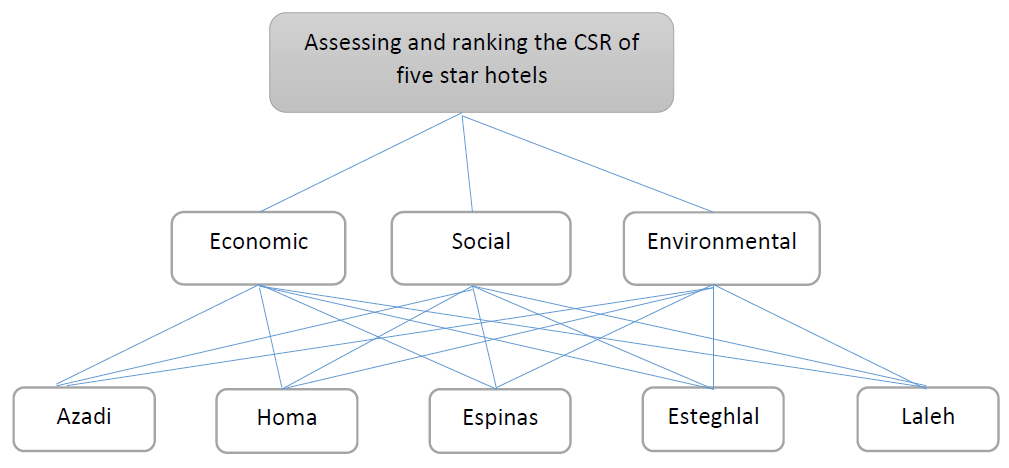 | Figure 1. The hierarchical structure for selecting the best alternatives |
3.2. AHP Model
- The AHP is a multi-attribute decision tool that allows financial and non-financial, quantitative and qualitative measures to be considered and trade-offs among them to be addressed (Kheiri et al, 2016). The AHP is aimed at integrating different measures into a single overall score for ranking decision alternatives.AHP model has the advantage of highlighting the main attributes, strengths and weaknesses of every alternative. This mathematical method stresses the key role of selecting the main criteria and the decision about their importance. In AHP model the priorities are determined by comparing each option with all the others, i.e. making relative comparisons, not absolute assessments.This section provides an explanation of the AHP model, in particular of the calculation of weights, starting from the paired comparison technique, and of the consistency verification. Determining the weights of each alternative signifies a numerical value that shows the importance compared to each of the criteria. In other words, AHP answer this question whether one criteria is preferable to another and if so, to what extent. The operation has to be entrusted to some experts familiar with the subject, who have been asked to express their personal preferences according to a scale developed by Saaty (Saaty 1987).The description is developed in three steps (Saaty 1987).Step 1: Compose a pair-wise comparison decision matrix (A)
 | (1) |
 | (2) |
 | (3) |
 | (4) |
3.3. Fuzzy TOPSIS Model
- The Technique for Order of Preference by Similarity to Ideal Solution (TOPSIS) is a criteria decisionmethod, which was originally developed by (Hwang and Yoon 1981) with further developments by Yoon in 1987, and Hwang, Lai and Liu in 1993. TOPSIS is based on the concept that the chosen alternative should have the shortest geometric distance from the positive ideal solution and the longest geometric distance from the negative ideal solution (Kheiri and Nasihatkon, 2015). It is a method of compensatory aggregation that compares a set of alternatives by identifying weights for each criterion, normalizing scores for each criterion and calculating the geometric distance between each alternative and the ideal alternative, which is the best score in each criterion. An assumption of TOPSIS is that the criteria are monotonically increasing or decreasing. In this paper, the approach of TOPSIS is extended to develop a methodology for solving multi-attribute decision making problems in fuzzy environments.Considering the fuzziness in the decision data, linguistic variables are used to assess the weight of each criterion and the rating of each alternative with respect to each criterion. The decision matrix is converted into a fuzzy decision matrix and constructed a weighted normalized fuzzy decision matrix once the decision makers’ fuzzy ratings have been pooled. The lower bound value of alternatives has been designed to obtain the distance value of the corresponding alternatives for detecting the fuzzy positive ideal solution (FPIS) and the fuzzy negative ideal solution (FNIS). Then, the fuzzy similarity degree of each alternative is calculated from FPIS and FNIS, respectively. Finally, a closeness coefficient is defined for each alternative to determine the rankings of all alternatives. The higher value of closeness coefficient indicates that an alternative is closer to FPIS and farther from FNIS simultaneously. Some important basic definitions of fuzzy sets and numbers based on recent work by (Dağdeviren, Yavuz et al. 2009) is provided:Definition 1. A fuzzy set ã in a universe of discourse X is characterized by a membership function µã (x) which associates with each element x in X, a real number in the interval [0, 1]. The function value µã(x) is termed the grade of membership of x in ã.Definition 2. A fuzzy number is a fuzzy subset of the universe of discourse X that is both convex and normal. Fig. 2 shows a fuzzy number ã in the universe of discourse X that conforms to this definition.
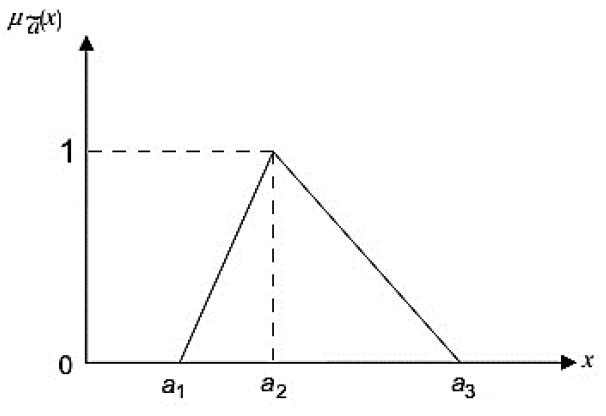 | Figure 2. A triangle Fuzzy number ã |
 | (5) |
 | (6) |
 | (7) |
 = (a1, a2, a3) and
= (a1, a2, a3) and  = (b1, b2, b3) be two triangular fuzzy numbers, then the vertex method is defined to calculate the distance between them.
= (b1, b2, b3) be two triangular fuzzy numbers, then the vertex method is defined to calculate the distance between them. | (8) |
 | (9) |
 ∙ A set of performance ratings of Aj (j = 1, 2,..., J) with respect to criteria Ci (I = 1, 2,..., n) called
∙ A set of performance ratings of Aj (j = 1, 2,..., J) with respect to criteria Ci (I = 1, 2,..., n) called
 | (10) |
 = 1, 2,..., n, J = 1, 2, ..., J) for alternatives with respect to criteria. The fuzzy linguistic rating
= 1, 2,..., n, J = 1, 2, ..., J) for alternatives with respect to criteria. The fuzzy linguistic rating  preserves the property that the ranges of normalized triangular fuzzy numbers belong to [0, 1]; thus, there is no need for normalization.Step 2: Calculate the weighted normalized fuzzy decision matrix. The weighted normalized value
preserves the property that the ranges of normalized triangular fuzzy numbers belong to [0, 1]; thus, there is no need for normalization.Step 2: Calculate the weighted normalized fuzzy decision matrix. The weighted normalized value  calculated by Eq. 9.Step 3: Identify positive-ideal (A+) and negative ideal (A-) solutions. The fuzzy positive-ideal solution (FPIS, A+) and the fuzzy negative-ideal solution (FNIS, (A-) are shown in the following equations:
calculated by Eq. 9.Step 3: Identify positive-ideal (A+) and negative ideal (A-) solutions. The fuzzy positive-ideal solution (FPIS, A+) and the fuzzy negative-ideal solution (FNIS, (A-) are shown in the following equations: | (11) |
 is associated with benefit criteria and
is associated with benefit criteria and  is associated with cost criteria.Step 4: Calculate the distance of each alternative from A+ and A- using the following equations:
is associated with cost criteria.Step 4: Calculate the distance of each alternative from A+ and A- using the following equations: | (12) |
 | (13) |
 | (14) |
3.4. The Proposed Model and Findings
- The methodology applied in this paper is to assess and rank the CSR practices of all five star hotels in Tehran city. The proposed model for assessing and ranking CSR practices in five star hotels in Tehran, composed of AHP and fuzzy TOPSIS methods, consists of three basic stages: (1) identify the criteria to be used in the model, (2) AHP computations, (3) evaluation of alternatives with fuzzy TOPSIS and determination of the final rank.In the first stage, alternative hotels and the criteria which will be used in their evaluation are determined and the decision hierarchy are formed. AHP model is structured such that the objective is in the first level, criteria are in the second level and alternative hotels are on the third level.After the first stage, criteria used in CSR are assigned weights using AHP in the second stage. In this phase, pairwise comparison matrices are formed to determine the criteria weights. The experts from decision- making team make individual evaluations using the scale provided in Table 2 to determine the values of the elements of pairwise comparison matrices.
|
|
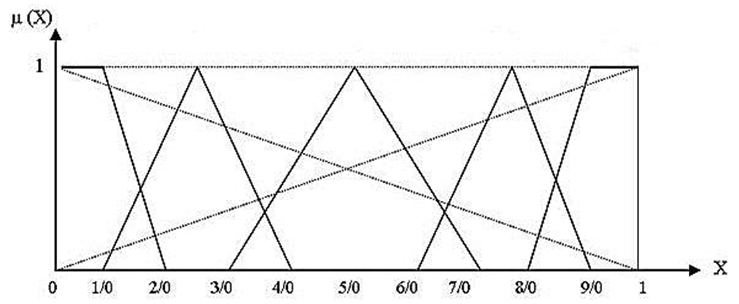 | Figure 3. Membership functions of linguistic values for criteria rating |
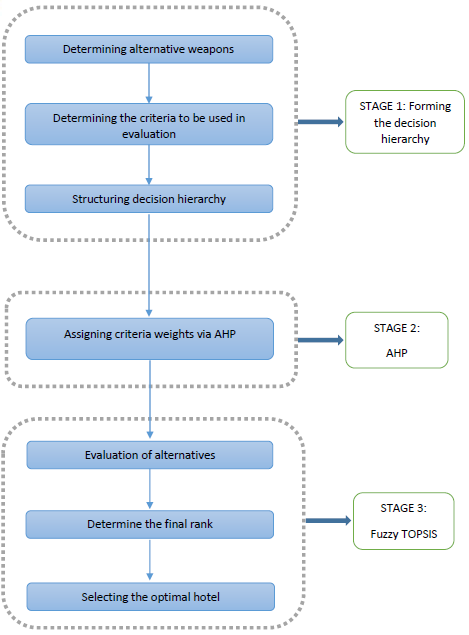 | Figure 4. Schematic diagram of the proposed model for hotels’ CSR assessing |
|
|
|
|
4. Discussion
- In comparison to the similar studies (Kucukusta, Mak et al. 2013, Manente, Minghetti et al. 2012) emphasized on importance of Social Responsibility Behavior in this century. Akama & Kieti (2007) According to their findings, accommodation sector in tourism industry must have an active role in media, especially in social media like Facebook, Tweeter, YouTube and Myspace. Kasim (2006) found that if hotels work on their social media marketing, they can improve their sales and profits. Panapanaan, Linnanen et al (2003) argued if new businesses don’t work on their behavioral on social media, they will experience high rate of risk in market. Dağdeviren, Yavuz et al. (2009) and Miller (2000) found that successful hotels manage their contents on the net and most of them have an independent department in this area. All of these researches prove that how Social Responsibility Behavior is important in tourism industry and especially in hotel sector.
5. Conclusions
- A strong current trend is the use of sustainable development theory to propose a new dimensioning of CSR composed of not only economic but also social and environmental aspects (Panapanaan, Linnanen et al. 2003). Furthermore, as argued in the literature, the application of the principles of CSR is highly conditioned by the contextual features of the sectors to which it is applied (Carroll 1999, Campbell 2007).This paper has looked at the concept of CSR in terms of the hotel industry. It adopted a qualitative approach to assessing and ranking the CSR practices in the five star hotels in Tehran, with a view to addressing three major dimensions of CSR i.e. economic, social and environmental factors. For this reason, the study, after underlining the meaning and significance of CSR and its dimensions, has focused on the analysis of the practices of hotels responsibility. Therefore, an effective evaluation approach is essential to improve decision quality. This study, presenting a scientific framework to assess and rank the CSR dimensions using the analytical hierarchy process (AHP) and the triangular fuzzy numbers to express linguistic values that consider the subjective judgments of evaluators. The proposed model is based on the comparisons of hotel brand alternatives according to identified criteria. AHP and fuzzy TOPSIS compound decision-making method has been used in proposed model. AHP is used to assign weights to the criteria to be used in CSR factors, while fuzzy TOPSIS is employed to determine the priorities of the alternatives. The weights obtained from AHP are included in decision-making process by using them in fuzzy TOPSIS computations and the alternative priorities are determined based on these weights. Proposed model has significantly increased the efficiency of decision-making process in hotel rankings.Definitely, this paper may suffer some setbacks. Consequently, some limitations like time and so on should be taken into account. These limitations can be overcome in the direction of the future research.
 Abstract
Abstract Reference
Reference Full-Text PDF
Full-Text PDF Full-text HTML
Full-text HTML